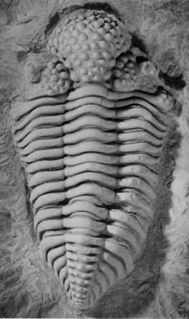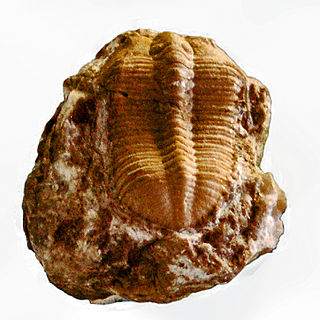
Phacopida ("lens-face") is an order of trilobite that lived from the Late Cambrian to the Late Devonian. It is made up of a morphologically diverse group of related suborders.

Calymene is a genus of trilobites in the order Phacopida that are found throughout North America, North Africa, and Europe in primarily Silurian outcrops. Calymene is closely related to Flexicalymene, and both genera are frequently found enrolled. Calymene trilobites are small, typically 2 cm in length. The cephalon is the widest part of the animal and the thorax usually has 13 segments.

Flexicalymene is a genus of trilobites of the order Phacopida, suborder Calymenina. They are found abundantly in North America. Flexicalymene specimens can be mistaken for Calymene, Gravicalymene, Diacalymene and a few other Calymenina genera. They are used as an index fossil in the Ordovician. Ohio and North America are particularly known for being rich with Flexicalymene fossils. Species include F. meeki and F. retrorsa, F. granulosa, F. senaria and F. croneisi (Ontario).

Gravicalymene is a genus of trilobites from the order Phacopida, suborder Calymenia. Gravicalymene has been a 'hot button' trilobite lately. The species that are currently in this genus have been in Calymene and Sthenocalymene. One thing that seems to be consistent with the genus Gravicalymene is that they sometimes occur in dolomitic limestone and that many occur in the Silurian age.

Calymene niagarensis is a species of trilobite belonging to the genus Calymene. These nektobenthic carnivores lived in the Middle Silurian, from 436.0 to 426.2 Ma.

Calymene blumenbachii, sometimes erroneously spelled blumenbachi, is a species of trilobite discovered in the limestone quarries of the Wren's Nest in Dudley, England. Nicknamed the Dudley Bug or Dudley Locust by 18th-century quarrymen it became a symbol of the town and featured on the Dudley County Borough Council coat-of-arms. Calymene blumenbachii is commonly found in Silurian rocks and is thought to have lived in the shallow waters of the Silurian, in low-energy reefs. This particular species of Calymene is unique to the Wenlock series in England, and comes from the Wenlock Limestone Formation in Much Wenlock and the Wren's Nest in Dudley. These sites seem to yield trilobites more readily than any other areas on the Wenlock Edge, and the rock here is dark grey as opposed to yellowish or whitish as it appears on other parts of the Edge, just a few miles away, in Church Stretton and elsewhere. This suggests local changes in the environment in which the rock was deposited.

Selenopeltis is an extinct genus of odontopleurid trilobites in the family Odontopleuridae.

Balizoma is a genus of trilobites from the family Encrinuridae established by David J. Holloway in 1980. It has only been found in rocks of Silurian age. Its type species, B. variolaris, is currently the only named species of the genus, and is found in England. The neotype of B. variolaris was collected from the Much Wenlock Limestone Formation at Dudley, West Midlands. That specimen was first illustrated in Sir Roderick Impey Murchison's classic book, The Silurian System. B. variolaris was the original "strawberry-headed" trilobite of Dudley, so-named because of its nodular glabellar tubercles, and well known to early trilobite collectors. Additional species were originally assigned to Balizoma, but were subsequently placed in other encrinurine genera.
Anchiopsis is a genus of trilobite in the order Phacopida, which existed in what is now New York, U.S.A. It was described by Delo in 1935, and the type species is Anchiopsis anchiops, which was originally described as Calymene anchiops by Green in 1832.
Calymenesum is a trilobite in the order Phacopida that existed in what is now China during the middle Ordovician. It was described by Kobayashi in 1951, and the type species is Calymenesum tingi, originally described under the genus Calymene by Sun in 1931. The species was described from the Shistzupu Formation in Guizhou, China.

Chasmops is a trilobite in the order Phacopida that existed during the upper Ordovician in what is now Estonia. It was described by McCoy in 1849, and the type species is Chasmops odini, which was originally described under the genus Calymene by Eichwald in 1840. It also contains the species C. maxima.
Deacybele is a genus of trilobites in the order Phacopida, that existed during the upper Ordovician in what is now Ireland. It was described by Whittington in 1965, and the type species is Deacybele arenosa, which was originally described under the genus Calymene by McCoy in 1846. The type locality was the Avoca Formation.

Dipleura is a genus of trilobites in the order Phacopida. It was described by Green in 1832, and the type species is Dipleura dekayi. The type locality was in the Hamilton Group in New York.

Eodalmanitina is a trilobite in the order Phacopida, that existed during the middle Ordovician in what is now France. It was described by Henry in 1964, and the type species is Eodalmanitina macropthalma, which was originally described under the genus Calymene by Brongniart in 1822. The type locality was in Loire-Atlantique.
Guichenia is a trilobite in the order Phacopida, that existed during the middle Ordovician in what is now France. It was described by Henry in 1968, and the type species is Guichenia dufouri, which was originally described under the genus Dalmanites by Tromelin and Lebesconte in 1876. The type locality was the Calymènes Shale, in Loire-Atlantique.

Calymene celebra is a Silurian species of trilobites of the order Phacopida and also the state fossil of Wisconsin. It is found in Illinois, Indiana, and Wisconsin.

Birmanites is a genus of trilobites in the order Asaphida, family Asaphidae.

Metacalymene is a genus of trilobites in the order Phacopida, family Calymenidae. This genus is considered monotypic, containing only the type species:

Planiscutellum is a genus of trilobites in the order Corynexochida family Styginidae. These trilobites were nektobenthic detritivore. They lived in the Silurian period in the upper Ludlow epoch, from 422.9 ± 1.5 to 418.7 ± 2.8 million years ago.

Panderia is a genus of trilobites in the order Corynexochida.


















